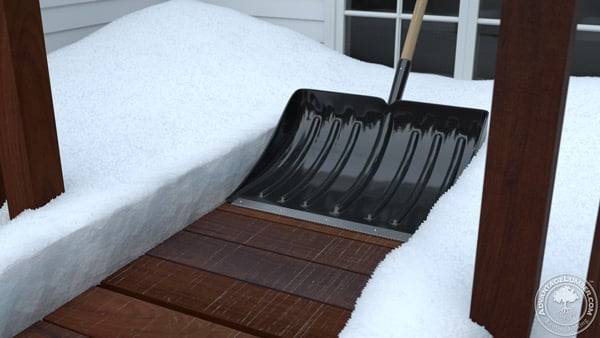If this is your first time facing snow on your brand-new deck, you may have a lot of questions about how to remove snow safely. We offered a few tips and tricks last month, but in this article we wanted to give you the biggest DO NOTs when it comes to clearing away the white stuff.
Salt:
Salt is probably the worst thing to use on your deck. As a melting agent, salt is a necessary evil that wreaks havoc on vehicles and utility lines but keeps roads open and prevents black ice from forming. As it melts the ice, salt dissolves into the forming water. This water then sinks into cracks in the wood and into areas where metal fasteners hold your deck together, causing corrosion. Once corrosion sets in, it can lead to the very serious situations including deck collapse.
Tarp Covering:
It’s a fun idea to cover your entire deck, right? It’s simple, it covers everything, and every time it snows, you just pull the tarp and all the snow falls off. Unfortunately, while this may be easy, a tarp can be detrimental to the health of your deck. A tarp on top of the deck prevents airflow. If this occurs, your boards can begin to warp and buckle, pulling away from joist. This exposes fasteners and cracked boards to freeze and thaw cycles that can break your deck.
Steel-Tipped Shovels:
They’re quick and everyone has them in their garage, but steel-tipped shovels can scratch deck boards. The cracks are ugly, but even worse is that snow can get in, melt, and then re-freeze, slowly prying the boards apart. While small scratches can be sanded during the spring, deep gouges will require replacement boards. Avoid all this by using rubber-tipped shovels to clear the snow off your deck.

I have a question regarding ipe railing which I installed. What can I apply to provide a smooth finish for hands. Poly does not work, suggestions?
All we suggest is just our Ipe Oil. Before doing that, try sanding it with very fine sandpaper, so it becomes smooth.
We purchased 350 sqft of 5/4 x 4″ x 12′ long std Ipe from Advantage spring of 2017. The deck is going into it’s second Seattle winter. Below are a few questions and concerns.
Item 1
A few of the boards that required significant force from the hardwood wrench to remove the crook are showing signs of stress cracking along the grain a few inches long in random spots. What can be done to mitigate this condition?
Item 2
What do you recommend for protecting the Ipe during a Seattle winter, ie, lots of rain. We have applied Ipe oil two times, once after installation in July of 2017 and a second time in May of 2018.
My Advantage Ipe deck is going into its second Seattle winter. During install I was very careful to use Ipe end grain sealer on all cut ends. I applied it to the end grain and approx. 1/2 inch up to board. At the runoff end of the deck a few of the boards are showing the beginnings of an end grain checking. What can I do to mitigate the checking on these boards? Should I apply Ipe end grain sealer a few inches up the board along its surface. Concerned about doing this as it leaves the appearance of the surface a bit different from the rest of the board.
My deck is raised eight feet above the open patio underneath. Would this provide the necessary air flow to allow me to tarp my deck for winter?
You’d have good airflow beneath your boards, but not on top. It’s the same reason we recommend at least 18″ of ground clearance when building a deck, so that the top and bottom of the boards will both have good airflow. Otherwise, the side that dries faster will shrink, causing the boards to warp.
I’m replying to this comment:
“You’d have good airflow beneath your boards, but not on top. It’s the same reason we recommend at least 18″ of ground clearance when building a deck, so that the top and bottom of the boards will both have good airflow. Otherwise, the side that dries faster will shrink, causing the boards to warp.”
————————————————————————–
How would it be getting wet if it’s covered? You said one side would dry faster but if it’s covered then it would not be getting wet on top OR bottom. 🤔 (assuming it’s done correctly)
It’s not just moisture from precipitation you have to worry about. You can still get condensation, and you have to think about the moisture that’s present in the wood itself. Even if the tops of the boards stay relatively dry because of the tarp, the bottoms will be even dryer because of the better air flow. It’s that difference between the top and bottom that causes the problems.
I put down a tarp first then a wooden pallet, then I stacked my firewood on top of the pallet. Will this stain my composite deck?
It is possible that the tarp could trap moisture and dirt which could lead to mold and algae growth which would increase the chances of staining.